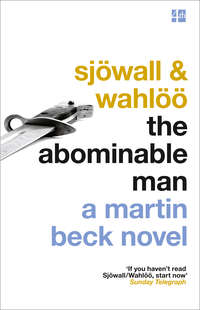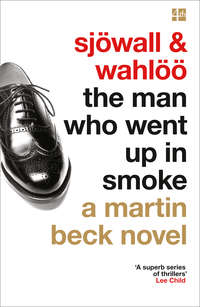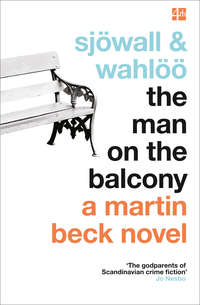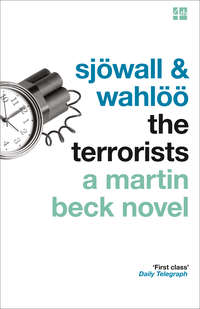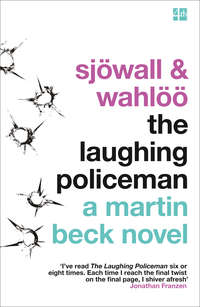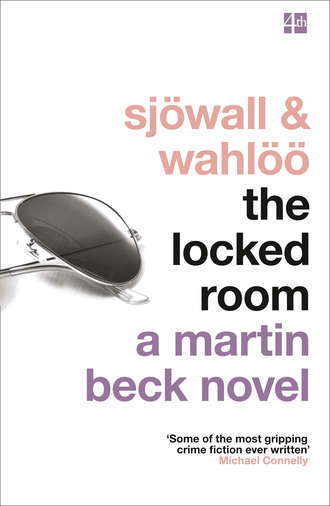
Полная версия
The Locked Room

MAJ SJÖWALL
AND PER WAHLÖÖ
The Locked Room
Translated from the Swedish by Paul Britten Austin

Copyright
4th Estate
An imprint of HarperCollinsPublishers 1 London Bridge Street London SE1 9GF
www.4thEstate.co.uk
This ebook first published by Harper Perennial in 2009
This 4th Estate edition published in 2016
This translation first published by Random House Inc, New York, in 1973
Originally published in Sweden by P. A. Norstedt & Söners Forlag
Copyright text © Maj Sjöwall and Per Wahlöö 1972
Copyright introduction © Michael Connelly 2007
Cover photograph © Shutterstock
PS Section © Richard Shephard 2007
PS™ is a trademark of HarperCollinsPublishers Ltd
Maj Sjöwall and Per Wahlöö assert the moral right to be identified as the authors of this work.
A catalogue record for this book is available from the British Library
This novel is entirely a work of fiction. The names, characters and incidents portrayed in it are the work of the authors' imagination. Any resemblance to actual persons living or dead, events or localities is entirely coincidental.
All rights reserved under International and Pan-American Copyright Conventions. By payment of the required fees, you have been granted the non-exclusive, non-transferable right to access and read the text of this e-book on-screen. No part of this text may be reproduced, transmitted, down-loaded, decompiled, reverse engineered, or stored in or introduced into any information storage and retrieval system, in any form or by any means, whether electronic or mechanical, now known or hereinafter invented, without the express written permission of HarperCollins.
Source ISBN: 9780007439188
Ebook Edition © 1972 ISBN: 9780007323456
Version: 2016-03-30
From the reviews of the Martin Beck series:
‘First class’
Daily Telegraph
‘One of the most authentic, gripping and profound collections of police procedural ever accomplished’
MICHAEL CONNELLY
‘Hauntingly effective storytelling’
New York Times
‘There's just no question about it: the reigning King and Queen of mystery fiction are Maj Sjöwall and her husband Per Wahlöö’
The National Observer
‘Sjöwall/Wahlöö are the best writers of police procedural in the world’
Birmingham Post
Contents
Cover
Title Page
Copyright
Praise
Introduction
Chapter 1
Chapter 2
Chapter 3
Chapter 4
Chapter 5
Chapter 6
Chapter 7
Chapter 8
Chapter 9
Chapter 10
Chapter 11
Chapter 12
Chapter 13
Chapter 14
Chapter 15
Chapter 16
Chapter 17
Chapter 18
Chapter 19
Chapter 20
Chapter 21
Chapter 22
Chapter 23
Chapter 24
Chapter 25
Chapter 26
Chapter 27
Chapter 28
About the Authors
Also by Maj Sjöwall and Per Wahlöö
About the Publisher
INTRODUCTION
What I don't like about writing an introduction is that you can't give anything away. You can only tease. You can say to the reader that you are in for a great ride, a great set of characters and a great story but you can't really make your case. You don't want to ruin it for the reader, so you can't exactly say why. So an introduction is sort of a ‘trust me’ proposition. I am here to tell you that if you are about to hop aboard and ride this story, then you are in for a great ride. Trust me.
I first took this ride about thirty years ago. A child of the movies and television, I have come to most of the masters of crime fiction through the visual medium. I read Raymond Chandler, Ross MacDonald and Joseph Wambaugh after seeing their work on the screen first. In each case I found the written stories that spawned the screen stories to be much deeper, more detailed and more gripping as they took the reader to the place no movie or television show can go; inside a character's thoughts.
So too was the case with the work of Maj Sjöwall and Per Wahlöö. The movie came first. My father and I both loved cop flicks. We went together often. One night in Fort Lauderdale, Florida, we went to see The Laughing Policeman with Walter Matthau and Bruce Dern. I didn't know it was based on a book until I saw the credits. I liked the movie, with the deeply brooding Detective Martin played by Matthau and the more reactive, loose cannon Detective Larsen played by Dern.
Not long after, I bought the book and quickly learned that the original story was not set in San Francisco, California, but in Stockholm, Sweden, and that the film's Detective Jake Martin was actually Detective Martin Beck in the book. No matter, I had invested. I read the book and there begun one of the best lessons a writer in waiting could ever have. In the next several years I moved from book to book in the Martin Beck series. I found it to be one of the most authentic, gripping and profound collection of police procedurals ever accomplished.
Sjöwall and Wahlöö set out to write a ten book, ten year glimpse of Swedish society, using the detective novel as the magnifying glass through which they would conduct their examination. They achieved their goal with great mastery. As a young reader with the intention/hope of writing crime novels someday, there were no better teachers when it came to showing how the detective story could rise above mere entertainment to the point of holding a mirror up to ourselves and the societies we build. Their work constantly reminds me of something the great writer Richard Price once said when questioned about his repeated forays into the realms of crime and detection. He said that he liked writing about detectives because when you circle around a murder long enough, you get to know a city. Long before he said that, Maj Sjöwall and Per Wahlöö knew it and practised it. The Martin Beck books tell us so much more than just how a crime is solved. Beautifully structured, textured and rendered, they tell us how a crime happens and how a city, country and society can often be complicit. They take us beneath the surface. They tell it like it is. Though the series now ages past thirty years, there is both a timeliness and time-lessness to the books that make them just as important now as the days they first came out of the bindery.
The Locked Room is flat out one of my favourites in the series. I am blown away by the authors' wonderful and original take on a standard mystery contraption – a locked room murder. I am in awe of the novel as a showcase of Martin Beck at his brooding best. The authors avoid the norms by weaving two seemingly separate investigations through the book; the story of a bank robbery gone bad and the story of Beck's investigation into what appears to be an unsolvable case, a man found shot to death in a room with the door and window locked. The case has been all but given up on until the detective returns to the job after recovering from wounds received in an earlier story. As he deals with his physical and mental recovery he works the locked room case over like a child works on a loose tooth with his tongue.
From the standpoint of a writer who has some experience attempting such things, there is no finer example of how to do it. Sjöwall and Wahlöö do it with completely convincing detail, humour and that most important ingredient; momentum. The book never lags. It never fails to keep the reader in his seat.
All the while the book carries the vivid imagery of Stockholm and its underbelly of crime that Beck traverses. I read this book long before I ever visited Stockholm but the sense of the city, its smells, its sounds, its hidden dangers and beauties are vibrantly alive. The city is as much a character in the book as any person who appears in its pages.
What's more, the book carries a dark irony: the idea of justice in which we are all guilty of something, and if we are not punished for the crimes we have committed then we are punished for those we have not. It is a daring proposition and one I have seen in a number of other books. But I have not seen it played out so well as in these pages.
As with the entire series of ten books, Martin Beck is the pole that holds the tent up in The Locked Room. His presence looms over every page whether he is actually on it or not. To me Beck is the original grinder, an empathist who takes it all in and grinds it constantly in his head. He grinds the case down to powder and only then does he see the solution. He operates with a certain melancholy that is just right. He is alone but not lonely. He is the thinking man's detective. The writer Joseph Wambaugh once said that the best crime stories are not about how a cop works on a case, but how a case works on a cop. Martin Beck is a most fitting example of the accuracy of this. And The Locked Room is a most fitting case for him to work and be worked upon.
Michael Connelly
1
The bells of St Maria struck two as she came out from the metro station on Wollmar Yxkullsgatan. Before hurrying on towards the Maria Square she halted and lit a cigarette.
The din of the church bells reverberated through the air, reminding her of the dreary Sundays of her childhood. She'd been born and grown up only a few blocks from the Church of St Maria, where she'd also been christened and confirmed – the latter almost twelve years ago. All she could remember about her confirmation classes was having asked the vicar what Strindberg had meant when he'd written of the ‘melancholy descant’ of the St Maria bells. But she couldn't recall his answer.
The sun was beating down on her back. After crossing St Paulsgatan she eased her pace, not wishing to break into a sweat. All of a sudden she realized how nervous she was and regretted not having taken a tranquillizer before leaving home.
Reaching the fountain in the middle of the square, she dipped her handkerchief in the cool water and, walking away, sat down on a bench in the shade of the trees. She took off her glasses and rubbed her face with the wet handkerchief, polished her glasses with the hem of her light-blue shirt, and put them on again. The large lenses reflected the light, concealing the upper half of her face. She took off her wide-rimmed blue denim hat, lifted up her straight blonde hair, so long it brushed against her shoulders, and wiped the nape of her neck. Then, putting on her hat, she pulled it down over her brow and sat quite still, her handkerchief crumpled up into a ball between her hands.
After a while she spread the handkerchief out beside her on the bench and wiped the palms of her hands on her jeans. She looked at her watch: half past two. A few minutes to calm down before she had to go.
When the clock struck 2.45 she opened the flap of the dark-green canvas shoulder bag that lay in her lap, picked up her handkerchief, which by now was completely dry, and without folding it slipped it into the bag. Then she got up, slung the leather strap of the bag over her right shoulder, and started walking.
Approaching Hornsgatan she grew less tense; everything, she persuaded herself, would work out fine.
It was Friday, the last day of June, and for many people the summer holidays had just begun. On Hornsgatan, both on the street itself and on the pavements, the traffic was lively. Emerging from the square, she turned off to the left and went into the shadow of the houses.
She hoped today had been a wise choice. She'd weighed the pros and cons and realized she might have to put off her project until next week. No harm in that, though she wasn't too keen on exposing herself to such mental stress.
She got there earlier than she'd planned and halted on the shady side of the street, observing the big window opposite her. Its shiny glass reflected the sunshine, and the heavy traffic partially blocked her view. But one thing she noticed. The curtains were drawn.
Pretending to be window shopping, she walked slowly up and down the pavement, and although there was a large clock hanging outside a watchmaker's shop nearby she kept looking at her watch. And all the while she kept an eye on the door on the other side of the street.
At 2.55 she walked over to the pedestrian crossing at the crossroads. Four minutes later she was standing outside the door of the bank.
Before pushing it open, she lifted the flap of her bag. Walking in, she let her gaze sweep over the office, a branch of one of Sweden's major banks. It was long and narrow; the front wall consisted of the door and the only window. To her right a counter ran all the way from the window to the short wall at the other end, and on her left four desks were fixed to the long wall. Beyond them were a low, round table and two stools upholstered in red-chequered material. Furthest away were some stairs, rather steep, disappearing below to what presumably was the bank's safe-deposit vault.
Only one customer had come in before her – a man. He was standing at the counter, stuffing banknotes and documents into his briefcase. Behind the counter two female cashiers were sitting. Further away a male cashier stood leafing through a card index.
Going up to one of the desks, she fished out a pen from the outer pocket of her bag, meanwhile watching out of the corner of her eye as the customer with the briefcase went out through the street door. Taking a deposit slip out of the holder, she began doodling on it. After a little while she saw the male cashier go over to the door and lock it. Then he bent down and flicked the hook holding open the inner door. As it swung closed with a hissing sound, he resumed his place behind the counter.
She took her handkerchief out of her bag. Holding it in her left hand and the deposit slip in her right, as she approached the counter, she pretended to blow her nose.
Then she stuffed the deposit slip into her bag, brought out an empty nylon shopping bag, and laid it on the counter. Clutching her pistol, she pointed it at the female cashier and, holding her handkerchief in front of her mouth, said: ‘This is a hold-up. The gun's loaded and if you make any trouble I'll shoot. Put all the money you've got into this bag.’
The woman behind the counter stared at her and, slowly taking the nylon bag, laid it down in front of her. The other woman stopped combing her hair. Her hands sank slowly. She opened her mouth as if to say something, but couldn't get a sound out. The man, who was still standing behind his desk, gave a violent start.
Instantly she pointed the pistol at him and yelled: ‘Stay where you are! And put your hands where I can see them.’
Impatiently waving the barrel of the pistol at the woman in front of her, who was obviously paralysed with fright, she went on: ‘Hurry up with the money! All of it!’
The cashier began stuffing wads of banknotes into the bag. When she'd finished, she laid it on the counter.
Suddenly the man at the desk said: ‘You'll never get away with this. The police will –’
‘Shut up!’ she screamed.
Then she threw her handkerchief into her open bag and grabbed the nylon shopping bag. It felt nice and heavy. Backing slowly towards the door, she pointed the pistol at each of the bank's employees in turn.
All of a sudden someone came running towards her from the stairway at the far end of the room: a tall, blond man in well-pressed pants and a blue blazer with shiny buttons and a big gold emblem stitched to the breast pocket.
A loud bang filled the room and went on thundering between the walls. As her arm jerked upward to the ceiling she saw the man in the blazer being flung backwards. His shoes were brand new and white, with thick, grooved, red rubber soles. Only as his head hit the stone floor with a horrible dull thud did she realize she'd shot him.
Dropping the pistol into her bag, she stared wild-eyed at the three horror-stricken people behind the counter. Then she rushed for the door. Fumbling with the lock, she had time to think before emerging into the street: ‘Calm now, I must walk perfectly calmly.’ But once out on the pavement, she started half-running towards the crossroads.
She didn't see the people around her – she was only aware of bumping against several of them and of the pistol shot which went on thundering in her ears.
She rounded the corner and started running, the shopping bag in her hand and the heavy satchel bumping against her hip. Jerking open the door of the building where she'd lived as a child, she took the old familiar way out into the courtyard, checked herself, and fell to a walk. Passing straight through the porch of a gazebo she came out into another back yard. She descended the steep stairway into a cellar and sat down on the bottom step.
She tried to cram the nylon bag down on top of the automatic in her shoulder bag, but there wasn't enough room. She took off her hat, glasses, and blonde wig, and stuffed them all into the shoulder bag. Her own hair was dark and short. She stood up, unbuttoned her shirt, took it off, and put that too into the bag. Under her shirt she was wearing a short-sleeved black cotton jumper. Slinging the shoulder bag over her left shoulder, she picked up the nylon shopping bag and went up the stairs to the yard again. She climbed over a couple of walls before at last finding herself in a street at the far end of the block.
Then she entered a small grocery, bought two litres of milk, put the cartons into a large paper bag, and laid her nylon shopping bag on top of them.
After which she walked down to Slussen and took the metro home.
2
Gunvald Larsson arrived at the scene of the crime in his own strictly private car. It was a red BMW, which is unusual in Sweden and in many people's eyes far too grand for a detective inspector, especially when he uses it on the job.
This beautiful Friday afternoon he'd just settled down behind the wheel to drive home, when Einar Rönn had come rushing out into the yard of police headquarters and dashed all his plans for a quiet evening at home in Bollmora. Einar Rönn too was a detective inspector in the National Murder Squad and very likely the only friend Gunvald Larsson had; so when he said he was sorry but Gunvald Larsson would have to sacrifice his free evening, he really meant it.
Rönn drove to Hornsgatan in a police car. When he got there, several cars and some people from the South Precinct were already on the spot, and Gunvald Larsson was already inside the bank.
A little group of people had gathered outside the bank, and as Rönn crossed the pavement one of the uniformed constables who stood there glaring at the spectators came up to him and said: ‘I've a couple of witnesses here who said they heard the shot. What shall I do with them?’
‘Hold 'em a moment,’ Rönn said. ‘And try to disperse the others.’
The constable nodded and Rönn went on into the bank.
On the marble floor between the counter and the desks the dead man, his arms flung wide and his left knee bent, lay on his back. One trouser leg had slipped up, baring a chalk-white Orlon sock with a dark blue anchor on it and a deeply sunburned leg covered with gleaming blond hairs. The bullet had hit him right in the face, and blood and brain matter had exuded from the back of his head.
The staff of the bank were sitting together in the far corner of the room, and in front of them Gunvald Larsson half stood, half sat, one thigh across the edge of a desk. He was writing in a notebook while one of the women spoke in a shrill, indignant voice.
Seeing Rönn, Gunvald Larsson held up his right palm at the woman, who immediately broke off in the middle of a sentence. Gunvald Larsson got up, went behind the counter, and, notebook in hand, walked over to Rönn. With a nod at the man on the floor he said:
‘He doesn't look too good. If you stay here I can take the witnesses somewhere, maybe to the old police station on Rosenlundsgatan. Then you can work here undisturbed.’
Rönn nodded. ‘They say it was a girl who did it,’ he said. ‘And she got away with the cash. Did anyone see where she went?’
‘None of the bank staff at any rate,’ Gunvald Larsson said. ‘Apparently there was a guy standing outside who saw a car drive off, but he didn't see the number and wasn't too sure of the make, so that's not much to go on. I'll talk with him later.’
‘And who's this?’ asked Rönn with a curt nod at the dead man.
‘Some idiot wanting to play the hero. He tried to fling himself at the robber, and then of course, in sheer panic, she fired. He was one of the bank's customers and the staff knew him. He'd been in here going through his safe-deposit box and came up the stairway over there, right in the middle of it all.’ Gunvald Larsson consulted his notebook. ‘He was director of a gymnastics institute, and his name was Gårdon. With an “å”’.
‘I guess he thought he was Flash Gordon,’ Rönn said.
Gunvald Larsson threw him a questioning look.
Rönn blushed, and to change the subject said: ‘Well, I expect there are some photos of her in that thing.’ He pointed to the camera fixed beneath the ceiling.
‘If it's properly focused and also has some film in it,’ Gunvald Larsson said sceptically. ‘And if the cashier remembered to press the button.’
Nowadays most Swedish banks are equipped with cameras that shoot when the cashier on duty steps on a button on the floor. This was the only thing the staff had to do in the event of a holdup. With armed bank robberies becoming ever more frequent, banks had issued orders to their staff to hand over any money demanded of them and in general not to do anything to stop robbers or to prevent them getting away that might risk their own lives. This order did not, as one might be led to believe, derive from any humanitarian motives or any consideration for bank personnel. It was the fruit of experience. It is cheaper for banks and insurance companies to allow robbers to get away with their haul than to be obliged to pay out damages and maybe even support the victims' families for the rest of their lives – which can so easily be the case if someone gets injured or killed.
Now the police surgeon arrived, and Rönn went out to his car to fetch the murder kit. He used old-fashioned methods, not infrequently with success. Gunvald Larsson left for the old police station on Rosenlundsgatan, together with the staff of the bank and four other people who had identified themselves as witnesses.
He was lent an interrogation room, where he took off his suede jacket and hung it over the back of a chair before beginning the preliminary examinations. The first three statements given by the bank personnel were as good as identical; the four others diverged widely.
The first of these four witnesses was a forty-two-year-old man who, when the shot had gone off, had been standing in a doorway five yards from the bank. He'd seen a girl in a black hat and sunglasses hurry past, and when, according to his own statement, half a minute later, he'd looked down the street, he'd seen a green passenger car, probably an Opel, pull out from the kerb fifteen yards away. The car had disappeared quickly in the direction of Hornsplan, and he thought he'd seen the girl with the hat in the back seat. He hadn't caught the car's registration number but believed it to be an ‘AB’ plate.


